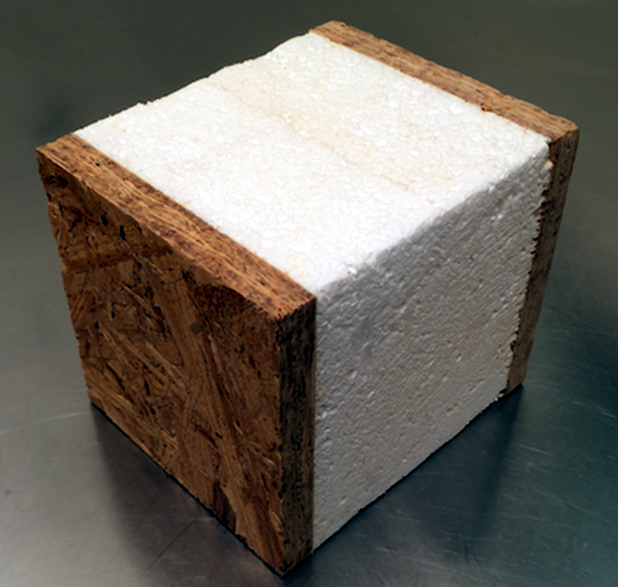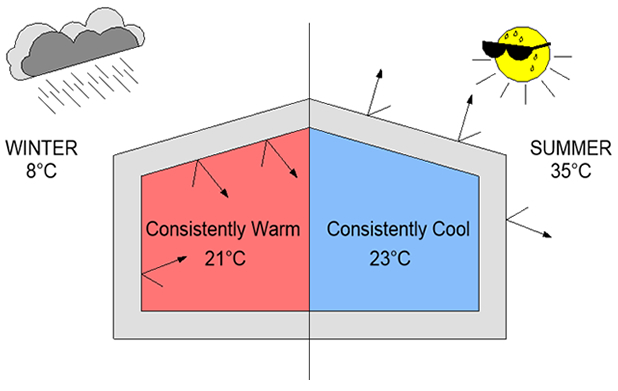Comparison: SIPs Vs Other Building Products - Part 4: Insulated Panels (Non-Structural)

‘One panel fits all’ IPS, commonly incorrectly sold as SIPS, are generally a non-structural panel system with a moisture resistant, fibre cement, magnesium oxide, or other board sandwiched with an insulation core forming a panel that is sold as a complete wall system.
Insulated Panels – Non-structural
The structure usually has a steel system incorporated into the panel core, which re-introduces thermal bridging and counteracts the science of how SIPS work.
As steel is a conductor, energy is freely transferred from inside to outside, and vice-versa which reduced the energy performance of the building and can cause moisture build up within the panel, causing mould within a very short period of time.
The simplistic idea of ‘IPS’ is to reduce the additional layers such as the ventilated cavity, cladding and internal lining, deemed as not required by the inexperienced, can, and most likely will, cause issues such as cracking due to movement, which in turn will lead to moisture ingress.
Panel jointing and penetration detailing has not yet been fully designed or grasped for these systems, causing water ingress and trapping it within the structure. This causes paint to chip off and bulging of internal finishes.
Moisture ingress into a structure such as this is almost always detrimental. We’ve see the leaky building crisis in New Zealand, but this kind of detailing is causing problems closer to our own doorstep, as a full housing estate of home owners in Newman, Western Australia will confirm.
Seek Assurance
When choosing your SIPs supplier, ensure the provider is reputable with a professional service and proven background including technical support. The building products you use should be certified and be manufactured to strict operational standards such as ISO9001, Codemark Approved.
Choose a SIPs panel system that manages moisture, is structural, and without thermal breaks, and a reputable experienced supplier.
Structural Insulated Panels (SIPs)
SIPs always seem to be an “up and coming” building product. There are a few SIPs systems that work fantastically well, and there are many who try to create a simpler ‘one panel does all’ scenario. This is a contributing factor in SIPs' slower market growth in Australia, but awareness and education of SIPs panels is ever-increasing due to their high reputation internationally.
Traditional SIPs have a very steady stronghold in the building markets in the US, UK, Europe and Japan. Generally comprising of OSB (Orientated Strand Board) as both structural skins, with an insulated core, commonly PIR (Polyisocyanurate) or EPS (Expanded Polystyrene).
 A cross-section of a SIPs Industries panel.
A cross-section of a SIPs Industries panel.
The SIPs building system can form Floors, Walls and Roofs and they are of various thicknesses of insulation. This means that the R-Rating varies between the thicknesses, but even the thinnest panel is quite good.
The system is similar to timber frame in that a breather membrane is applied to the external side, with a ventilated cavity to allow for vapour and moisture to ventilate away, and then cladding outside of this. Internally the finish is generally plasterboard directly fixed to the SIPs.
There are many advantages to using SIPs such as the speed of install (a single storey 4 bedroom home, walls and roof can be erected in under 5 days), the accuracy of dimensions (SIPs are almost millimetre perfect) and fitting of fixed furniture is a dream due to the straight and constant structural board.
But these are all secondary to the thermal performance of the structure. There are no gaps, very little thermal bridging and have been tested to be air-tight. This kind of construction can almost ensure that moisture is not travelling into the structure.
SIPs are generally the benchmark product for Passivhaus construction due to the ability to achieve air-tightness whilst maintaining a continuous thermally broken insulation layer.
Comfort of living within a SIPs enveloped home is a noticeable environment. It is quiet as the acoustic performance of the air-tight building system keeps noise out, the ambient and consistent temperature throughout the building are maintained due to insulation and no draughts flow, which is a standout sensation.
And adding an Energy Recovery Unit (MHRV) means that constant fresh air is delivered into the building and is brought to the inside temperature by passing the outgoing stale and moist air within the unit mechanism. This saves dollars on energy and gets fresh air to the occupants and the building.
 SIPs create a comfortable ambience all year round.
SIPs create a comfortable ambience all year round.
Contact SIPs Industries on (08) 9494 2211 for more information and to chat about the many benefits of building your home with SIPs.
